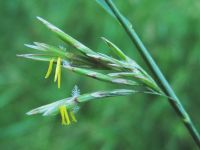- Bromus inermis
-
Wehrlose Trespe Systematik Unterklasse: Commelinaähnliche (Commelinidae) Ordnung: Süßgrasartige (Poales) Familie: Süßgräser (Poaceae) Unterfamilie: Pooideae Gattung: Trespen (Bromus) Art: Wehrlose Trespe Wissenschaftlicher Name Bromus inermis Leyss. Die Wehrlose Trespe (Bromus inermis), auch unter der Bezeichnung Unbegrannte Trespe oder Unbewehrte Trespe bekannt, ist ein formenreicher, sommergrüner und ausdauernder Vertreter der Süßgräser (Poaceae). Sie kann als ein Futtergras mit mittelmäßigem Futterwert verwendet werden. Vor allem in den östlichen Teilen Europas wird das Gras wegen seiner Dürre- und Überschwemmungsresistenz genutzt[1].
Inhaltsverzeichnis
Vorkommen
Die Wehrlose Trespe ist ein in Deutschland zerstreut vorkommendes Süßgras, welches trockene, nährstoffreiche und basenreiche Böden und warme Standorte bevorzugt. Sie ist vor allem an Waldrändern, an Wegen, auf Äckern, in ruderalen Halbtrockenrasen oder Ruderalfluren zu finden. Derzeit ist es in Deutschland in Ausbreitung begriffen. Es kommt sonst weltweit in den kontinental getönten Klimazonen der Erde auf der Nord- und der Südhalbkugel vor.
Erkennungsmerkmale
Die Blütezeit der Wehrlosen Trespe reicht von Juni bis Juli. Sie ist ein relativ hohes, durch lange Ausläufer rasenbildendes Wiesengras, das bis 1 m hoch werden kann. Ihre Blätter sind flach und etwa 5 bis 9 mm breit. Die meist röhrig, geschlossenen Blattscheiden sowie die Blattspreiten sind kahl. Die grünlichen Blatthäutchen (Ligulae) sind unscheinbar und kurz; etwa 0,5 bis 2 mm lang.
Die Einzelblüten stehen in Form von Ährchen zu vier bis zehn in einer aufrechten Rispe. Die vielährigen Rispenäste stehen abwechselnd auf den Seiten einer vierkantigen Achse. Jedes Ährchen wird bis zu 3 cm lang. Die Deckspelzen sind lang eiförmig und auf dem Rücken abgerundet. Sie sind unbegrannt (daher der Name), zuweilen bespitzt, seltener auch mit 2 bis 4 mm langen Grannen, welche kurz unterhalb der Spitze entspringen. Die großen Staubbeutel sind auffällig gelb gefärbt. Die untere Hüllspelze ist einnervig, die obere dagegen dreinervig.
Quellen
- ↑ Aichele / Schwegler: Unsere Gräser (Kosmos Naturführer) (11. Auflage, 1998, Kosmos-Verlag) ISBN 3-440-07613-X
Literatur
- Grau, Kremer, Möseler, Rambold, Triebel: Gräser. Steinbachs Naturführer, Mosaik-Verlag, München, 1996. ISBN 3-576-10702-9
- E. Vogler: Gräserbestimmung nach Photos. Blackwell, Berlin, 1994. ISBN 3-8263-3018-8
Weblinks
Wikimedia Foundation.


